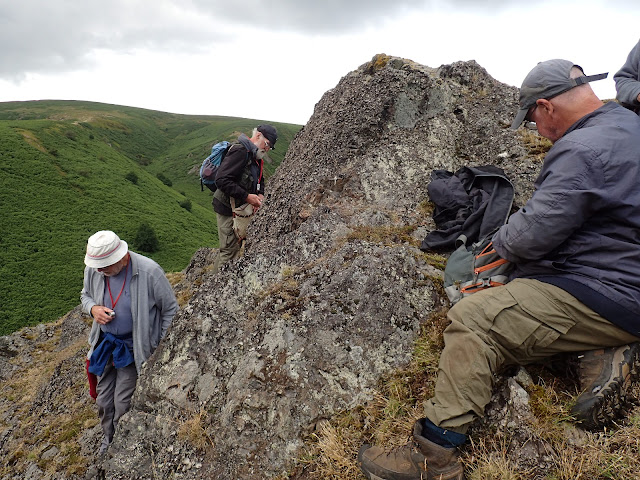Shropshire a county between the Midlands and Wales has some amazing geology, and this in turn produces fascinating lichens.
Yesterday we were at Nipstone Rock at the end of the Stiperstones
Today, Thursday 13 July 2023, we are going to the Long Mynd. We drive through Church Stretton and park on a narrow road above Jonathon's Hollow. (The steep sided valleys are called hollows, and/or batches)
(Please tell me if I have misnamed any of these species - especially those of you who came on the field meeting. )
The Long Mynd is approximately 7 miles (11 km) long by 3 miles (5 km) wide, The highest point on the Long Mynd is Pole Bank (1,693 ft, 516 m)
Here we are just starting to descend into Jonathon's Hollow
On the rocks just behind me from where I am taking this photo Eric and Mary showed us the Umbilicaria hirsuta which he had been delighted with when he first found it. (And still is) - It was a new record for England when he discovered it!
 |
Umbilicaria hirsuta
|
 |
Xanthoparmelia verruculifera -
(I find and compare Xanthoparmelia verruculifera and X loxodes later on this blogpost)
For those not familiar with the longest ever running Sit-com " Last of the Summer Wine" set in Holmfirth, see Nora Batty There were 295 episodes and 31 series between 1973 and 2010 and Nora featured in 245 of them. This brown Parmelia has wrinkles on the thallus lobes, and isidia in warts (But not cauliflower like warts as in X loxodes) The medulla is supposed to be KC+ pink or KC- (unlike X loxodes whose medulla is KC red-orange. It's is much darker brown than X loxodes. |
 |
| Somewhere uphill there must be a golf course... |
 |
| ??? not sure what this is |
 |
| I wonder if this is Lecanora membranacea |

 |
| Umbilicaria hirsuta |
2m below me the others in our slow ( more thorough? ) party are having coffee...
A walking couple come past us and tell us how they had been working with other volunteers the week before, removing scrub (gorse scrub) from some of these outcrops to allow space for the grayling butterfly (Hipparchia semele)  |
| Meanwhile much of the party have walked down - maybe only 1/8 mile, but (with wide angle picture) it looks a long way. |
The bracken is causing problems.
 |
| The bracken is growing on the thicker soil. |
Paul, Steve, Alastair
 |
Top left of the picture, though at the bottom of the hill
is a rock outcrop we look at after lunch |
 |
| Lasallia pustulata (centre) grows on the rocks too. |
 |
| This might be Varicellaria lactea - but do not have chance to test to see if the soralia go pink-red with C |
Eric takes me higher up the ridge to a flush with Bog Pimpernel and a Red Waxcap
 |
| The flush |
 |
| Bog Pimpernel |
 |
| A Small Copper butterfly on Marsh Thistle |
 |
| Sundew |
On the way back down to the others - Can you see Fred?
I meet Fred at "the summit" of the rock outcrop above the path

 |
| The yellow on the rock at the summit is Xanthoria ucrainica and Candelariella coraliza |
 |
| We then spend a long time puzzling over this lecanorine type lichen.. - which bottom right corner of this picture actually appears to have a lobed thallus - what dark pink apothecial discs it has! And the rims are a bit crenulate |
 |
More lobes here (top centre).. In spite of its dramatic location at the top of this rock, later that evening we decide that it must just be the (common) Lecanora muralis Protoparmeliopsis muralis. - Chewing Gum Lichen that can grow on tarmac and cement paving stones as well as on acid siliceous mountain roks
|
Next is lunch, beside a pleasant narrow stream at the bottom of the valley. On short turf with encroaching bracken. Happy memories of picking up pebbles in the stream. Paul C. finds three aquatic Verrucarias .. and takes them back. No photographs.
I press on and catch up with David Hill and others at a big outcrop where the stream in Jonathon's Hollow and the other Batch meet (referred to earlier in this post.)
 |
| Here there is some Lecidea fusco-atra |
 |
Lecidea fusco-atra - goes red with C (bleach)
Considering this is the third time I have seen it I should be getting able to recognise it - previously with the Cumbria group at Kirkstone Pass with John Douglas, and at Carrifran near Moffat with Caz and Brian earlier in April.
The BLS map for L fusco-atra shows it occurs over most of the UK ... So why haven't I noticed it in SD86 yet? (my home hectad) .. I must try using bleach more often on some of the possibilities that I find.
 | | This is Xanthoparmelia verruculifera - it is darker brown than some X loxodes we find close by. |
|
 |
David thinks this lichen might be Varicellaria hemispherica even though it usually grows on trees. - red with C
|
 |
| This turns out to be all Lecanora gangalodes |
 |
| This looks like a cup fungus to me, but David Hill suggests it is only Lecanora polytropa. The picture is just 5mm across |
 |
| Lecanora polytropa |
On a flatter, more soily area at the edge of this outcrop we find
 |
| Cladonia uncialis uncialis |
Time to go back to the centre. and we arrive there early - in time to go for a short walk in the centre grounds .. see next post.









































No comments:
Post a Comment